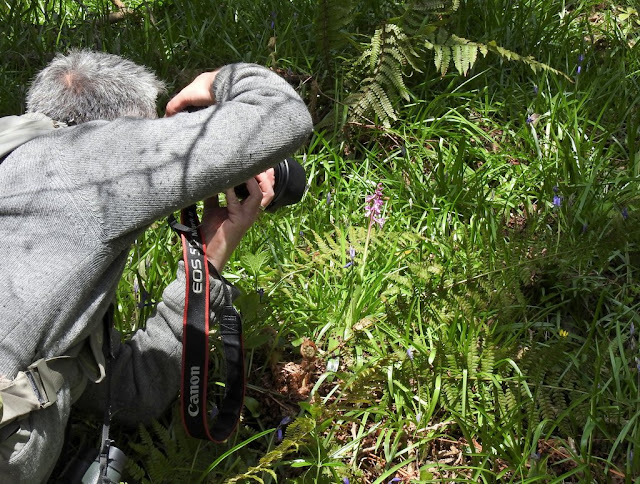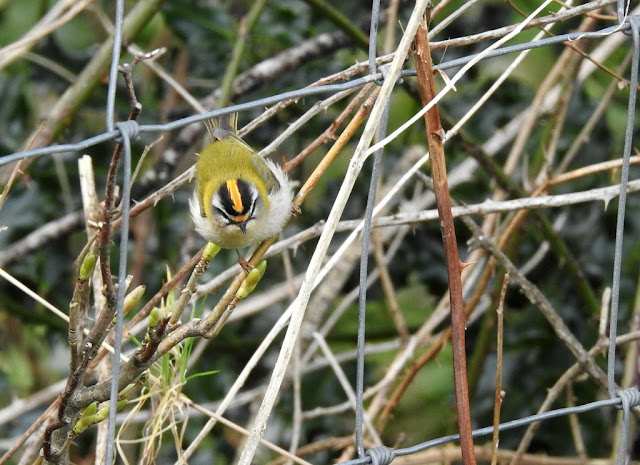If silver-halide film photography was still a thing, yesterday evening's efforts to get a passable shot of an in-flight hirundine would have bankrupted me. I was at Bride Valley Fish Farm again, still hoping for my first Sand Martin of the year. Pleasingly there were two, plus a bonus House Martin and about seven Swallows. But could I get a flight shot?

|
|
No. No I could not. |
This morning I had a date at Mapperton Wildlands again, accompanying Tom Brereton on a longer version of last weekend's rewilding tour. With about half an hour to play with beforehand, a quick visit to West Bay got the day off to a fine start with three newly arrived Wheatears on the harbour wall rocks...

|
|
Cracking little Wheatear, and its English seaside welcome |

|
|
My word, they are so gorgeous... |
A couple of the Mapperton cattle have just been fitted with Nofence collars, a technology which allows the herd to be controlled without the need for physical fences. Clever stuff...

|
|
One of the White Park girls with Nofence bling. |
Bird-wise it was mostly quiet, though squidging through a marshy patch we were treated to single Jack and Common Snipe. Typically the Jack Snipe flushed silently and very late, and pitched down again not far away, while the Common Snipe complained loudly and made for the horizon.
Tom found us our first flowering orchids of 2022...

|
|
Early Purple Orchid getting pappage |
After a slow lunch I sallied forth on a bit of a mission. I have never seen a Firecrest in potential breeding habitat, and today I hoped to do just that. It's not that I have never tried before, because I have. Once. It was in 1978, and the Royal Holloway College Ornithological Society arranged an outing to Wendover Woods with that exact aim. Firecrest was a pretty rare breeder back then, and I think Wendover Woods was a hotspot. Whatever, we didn't see any. I did tick Crossbill though, quite unsatisfactorily, as a little group flew over us, calling. Since that day, Firecrest has done very well, but this afternoon was still my first attempt to find potential breeders in 44 years!
There are many differences between the long-haired oaf of 1978 and the respectable author of this blog, but one of them is a really annoying function of age, and can be measured with depressing accuracy in decibels and kilohertz. I was quite worried that I wouldn't be able to hear a singing Firecrest any more. Well, very, very nearly, I can't...
I had generously been given the location of a bird which was singing in suitable habitat about ten days ago, so checked that out first. Success! Encouraged by this, I tried a few other nice-looking spots and found another singing male some 350m away in the same wood. Which made me wonder just how many might be out there undiscovered. Given a bit of time and effort, and much better ears than mine, who knows?
 |
| I guess a photographer migh be cursing those twigs? This is by far the best Firecrest photo I have ever taken, so I couldn't care less! |
 |
| Firecrest belting it out, almost inaudibly...sadly |
 |
| What a striking little beastie |
On a sonogram you can see that Firecrest song is pitched roughly in the 7-8kHz band. Unfortunately it isn't going to be very long before a sonogram will be the only way I can enjoy it. That is, visually...
That pic of the Firecrest singing is amazing! And let's face it, they look a lot better than they sound anyway ;) BTW, your top Whetaear pic has the Rottingdean Sea-lavender/Sea Heath patch in view, exceedingly rare in your neck of the woods. See the bottom right house in the background - they grow on the thin grassy sward beneath it, right at the bottom of the cliff path. Pete will tell ya more.
ReplyDeleteCheers Seth. I'm always looking for ways to spark some interest in plants, so I looked up Rottingdean Sea-lavendar, hoping it might ignite something...
DeleteMy heart sank. Plastic! 😄
Great Firecrest photo.
DeleteThe Sea-lavender is as plastic as, say, Little Owl but like Little Owl it is thriving in the wild. Obviously don't intend to go down the whole 'plastic' debate but what I think Seth is alluding to is the Sea-lavender is only thriving in the wild in three places in the UK one of which happens to be West Bay which is amazing!
Thanks Pete. Sorry, I was being a bit tongue in cheek there. It looks pretty smart and I shall definitely make an effort when it's in flower. 👍
DeleteGav, I wonder if use of a Bat detector could be a solution? I understand from a brief glance on the net that they can cover a frequency as low as 5kHz.
ReplyDeleteMust admit I hadn't thought of that, Ric! Cheers.
DeleteOutrageous Firecrest photos Gav, well done. That nice Wheatear habitat shot is lovely too...
ReplyDeleteThanks Stew, I am pretty gobsmacked myself!
Delete